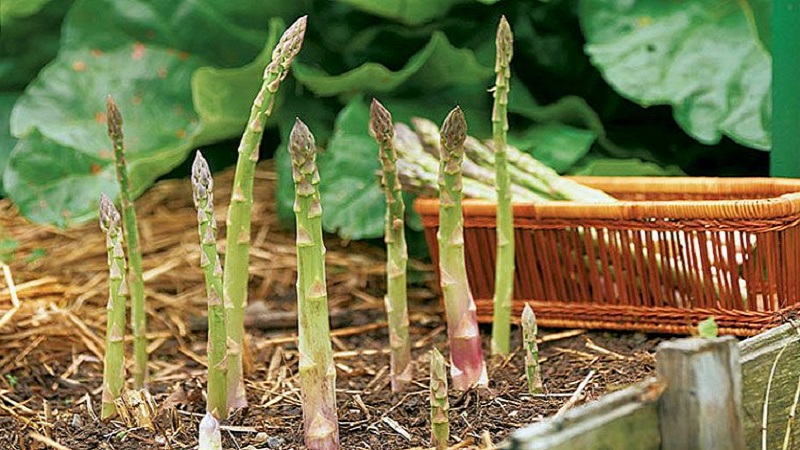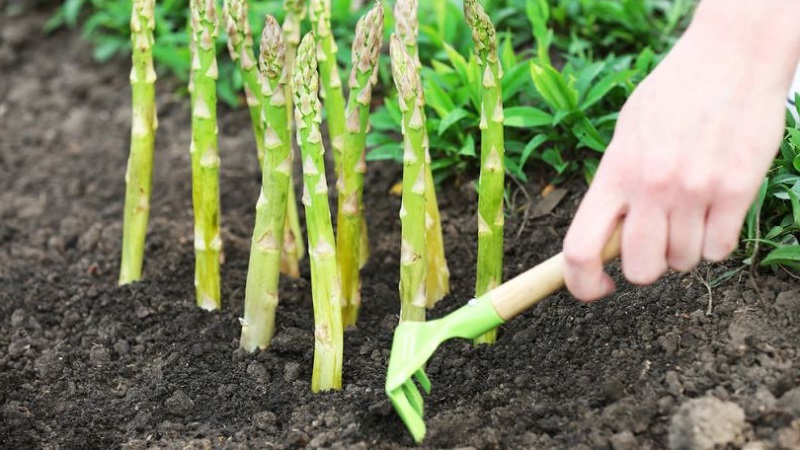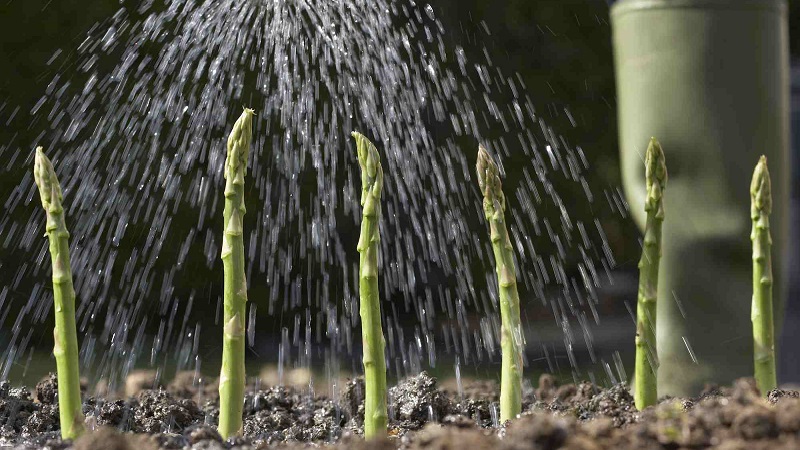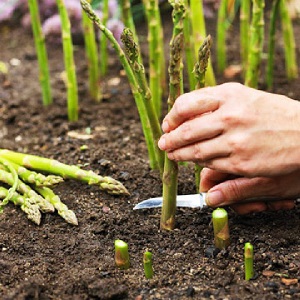How to Prepare Asparagus for Winter: A Step-by-Step Guide to Preparing Your Beds in Fall
Gardeners grow common asparagus more often for the sake of beautiful lush twigs that complement any floral bouquet. Not everyone knows that asparagus is an edible early vegetable.
Young fleshy shoots emerging from the ground after snow melt are used for food. They contain a complex of vitamins and useful compounds: vitamins B1, B2, B9, C, E, A, PP, iron, phosphorus, magnesium, calcium, proteins and carbohydrates, asparagine. In order for the asparagus growing in the garden not only to decorate the flower garden, but also to give a vitamin harvest, the plant must be provided with competent care in the autumn and wintering.
The content of the article
The importance and features of proper care for asparagus in the fall
It is no coincidence that asparagus is not cheap on store shelves. To provide proper care for a plant, it is important to know its biological characteristics.
Common asparagus is a dioecious plant - has male and female flowers on different individuals. Shoots of female plants are tastier and more nutritious.

How asparagus winters
Winter is a trial period for any perennial crop. In winter, vegetative buds are laid in asparagus.from which vegetable shoots develop later. In the Moscow region and regions with more severe winters, the plant requires shelter in the form of bulk beds of mulch.
How to prepare asparagus for winter
The culture of the first year, obtained from seeds, already has a well-developed root system by autumn... Autumn preparation of plants for wintering is a set of measures, including the preparation of the soil and the plants themselves.
Verification and control of pests
Many pests and diseases are visible on plants with the naked eye. Diseased plants differ from healthy ones by depressed growth, the presence of spots or dots on the stem, and the hanging tips of the shoots.
The culture is affected by such fungal diseases:
- Rust. Caused by a rust fungus that hibernates on plants and in the soil. The plant has yellowish rounded spots with black dots in the center. Plants planted on soils with a high groundwater table and poor drainage are more susceptible to diseases.
- Root rot. A fungal disease to which no asparagus variety is yet resistant. At the beginning of the disease, there is a browning of the root collar. The onset of the disease occurs due to root pruning when transplanting young plants.
- Cercosporosis. The leaves are covered with white or dirty gray spots with a dark bloom of sporulation. The disease progresses in cold and wet weather.
The culture has much less pests:
- Asparagus fly. Harmful to young plants and old plantations. It is not adults that are dangerous for plants, but its larvae, which eat young juicy shoots. As a result, plants slow down growth, deform, turn yellow and become unusable stems. Every 5 days, during the period of insect activity, the plants are sprayed with Methylparathion WP, Foltion 50 EC.
- Asparagus leaf beetle. Beetles and their larvae cause harm. In early spring, adult insects devour shoots and leaves. The larvae destroy the tops of the shoots, leaves, flowers and berries. To destroy the pupae, the beds are dug deeply. After cutting the shoots, they are sprayed with Karbofos.
After making sure that the asparagus is healthy, proceed to the further preparation of plants for the winter period.Affected plants are removed and burned.
Interesting on the site:
How asparagus grows: growing and care in the open field
Loosening, hilling
Loosening makes the soil more breathable and moisture-absorbing... Good aeration of the soil activates the rapid growth of the root system and the normal respiration of plant sprouts under the ground.

For the first time, the procedure is carried out in early spring, as soon as the soil thaws... Subsequent loosening is carried out regularly, after each watering or rain, so that a soil crust does not form. They loosen the ground under the plants for the last time in the fall, after cutting off the shoots.
In the row spacing, all weeds are pruned with a hoe, and weeding on the beds is done manually.
For softer, bleached stems hilling is a mandatory procedure. They begin to spud asparagus in the spring of the third year. By this time, the plants will grow up, get stronger and will be ready to please with the harvest.
Several hilling operations are carried out per season:
- After the snow melts in the asparagus beds, it is easy to distinguish the planting sites of the plants sleeping underground by last year's shoots. Near the main stem of the culture, a mound is made of a mixture of peat and humus with a height of 30 cm.
- If, after a long period of rains or inaccurate watering, the mound has eroded and a donkey, the procedure is repeated and spud to the required height.
- As the shoots appear and grow, the fertile substrate is periodically poured over.
If you prefer green shoots of a vegetable, you can skip hilling.
Fertilization
Asparagus is demanding on the level of soil fertility. Lack of the necessary nutrition is one of the main mistakes in growing it. For this reason, the culture does not provide the desired quantity and quality of products.
Feeding asparagus throughout the growing season:
- When laying a new plantation, in the fall, they dig up a plot to a depth of 30 cm (shovel bayonet) and apply organic fertilizers: rotted manure (cow or horse) - 6 kg per m22 on sod-podzolic soils (Moscow region). On sandy loam, the organic rate increases to 12 kg per m2.
- In the spring, after the snow melts and the soil thaws, the plants are fertilized with humus, at the rate of 10 kg per m2... Additionally, under adult bushes (from three years old), a complex mineral fertilizer ("Nitroammofosku") is applied - 30 g per m22 land.
- During the spring-summer period, the plants are watered with an organic solution (one part of the fertilizer for 6 parts of water). If bird droppings are used, then to prepare the solution, one part of the droppings is dissolved in ten parts of water. The frequency of dressings is 1 time per 3 weeks.
- In autumn, superphosphate is introduced into the soil (300-500 g per 10 m2) and 40% potassium salt. This will help the asparagus recover and gain strength before wintering.
Dry mineral fertilizers are scattered over the soil surface and close up when loosening. They prefer mineral fertilizer mixtures in the form of granules.
Important! Any liquid top dressing is carried out after watering, so as not to burn the plant roots.
Watering
Asparagus grows wild in the arid steppes of Asia, South America and is considered a drought tolerant plant. Do I need to water it in the garden? For watering asparagus, the rule is: it is better not to water than to pour.
Experienced gardeners believe that 7-10 waterings for the whole summer are enough for the culture. It is best to be guided by the condition of the soil in the garden: if its top layer is 2-3 cm dry, you can irrigate.

Asparagus seedlings need waterthan adult specimens. Until the seedlings get stronger and grow a powerful root system, they are watered as soon as the topsoil is slightly dry. The same regimen is maintained for two weeks after planting asparagus in open ground.
Reference. Cover the bed with a mulch layer (10 cm) to protect the soil from evaporation in the heat and prevent weed growth.As mulch, sawdust of deciduous trees, peat, humus or a mixture of these are used.
Pruning
In a leafless state, the plant overwinters easier and will give all his strength to the laying of future shoots. When to prune perennial asparagus before winter? Pruning is carried out before the onset of frost, when the weather is still warm in autumn. In the Moscow region, the best time is early October.
You will need a clean and sharp pruner to work.... All shoots are cut off. Patients are removed completely, and healthy ones are cut at a level of 3-5 cm from the ground.
 In addition to the autumn cut of shoots, during the season, the plants are pruned in case:
In addition to the autumn cut of shoots, during the season, the plants are pruned in case:
- Use of young seedlings for food. Ripening shoots need to be cut every 3-4 days. To determine whether the seedlings are ripe, it is enough to look at the soil at their base: in ripe ones, it rises like a "slide" and cracks.
- Sanitary cutting of diseased or dry shoots.
Sick shoots are burned after pruning, and the plantation is treated for diseases.
Attention! Do not overuse cutting branches for bouquets. Abundant pruning weakens the plant, making it unable to form thick shoots. Better for beauty to have separate 2-3 copies in the flowerbed.
Shelter for the winter
Asparagus is a cold-resistant crop... It is able to withstand frosts down to –25 ° C with sufficient snow cover. In the suburbs and northern regions of Russia, it happens that frosts hit, but there is still no snow. In such cases, the surface roots of asparagus will die without shelter.
Cover plants, guided by the weather forecast, mid-October-early November. As insulation, mulching of plantings with humus and a shelter from above with coniferous spruce branches or thin spunbond are suitable.
Read also:
Rules for successful preparation
Here are some tips for preparing asparagus in the fall. So, should be held:
- Pruning and inspecting plants for disease.
- Preventive treatment with a complex fungicide - "Fitosporin", "Topaz", "Topsin".
- The last feeding in the form of superphosphate and potassium salt.
- Hilling and mulching the plantation with humus.
- Before the supposed frosty night - covering the plantation with covering material.
How to care for asparagus in winter
In winter, the plantings sleep under the snow. But this does not prevent some rodents from hunting and feasting on the bark of fruit trees and tasty rhizomes of sleeping perennials.
Inspect the snow cover regularly... Trample snow near the asparagus plantings, lay out baits for moles and mice. If the snow cover is not enough, the weather is windy and frosty, throw snow on the beds from the paths.

Tips & Tricks
Experienced gardeners recommend:
- When feeding a culture, give preference to organics. It does not salt the soil.
- Feed the plants after each shoot to stimulate further growth.
- Asparagus does not like transplanting, so be serious about choosing a site.
- Saplings of one and two years of age can die if a lot of young shoots are cut off from them. Wait 3-4 years for maximum yield.
Conclusion
Asparagus requires a lot of attention and care. But, caring for her according to the rules, you can get a stable vegetable harvest for 15 years. And if you want to cook a dish with a vitamin plant in winter, you can select 3-4 copies separately and use them only for winter distillation.